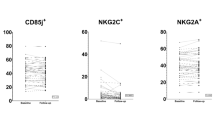Abstracts
Inflammatory and immunologic mechanisms are important for the initiation and the progression of atherosclerotic lesions. OxLDL and HSP-60 antigens are involved in the pathogenesis of atherosclerotic disease by triggering immune cells within the plaques. Through the MHC pentamer assays, we investigated the presence of OxLDL- and HSP-60-specific CD8+ T lymphocytes in twenty HLA-A2-positive patients suffering from coronary artery disease (10 NSTEMI and 10 stable angina). Similarly, 10 age- and sex-matched healthy subjects were enrolled as controls. Biological samples were collected within 6 h of admission to hospital, at 30 days and at 180 days. OxLDL- and HSP-60-specific CD8+ T lymphocytes were never detectable in the peripheral blood from all the healthy controls. On the contrary, at each scheduled time point, both of these specific cells could be detected in peripheral blood from all enrolled patients. More in detail, the flow cytometric analysis of MHC-1 pentamer OxLDL-specific CD8+ T lymphocytes revealed a sharp and significant increase at the hospital admission, within 6 h from the chest pain onset, followed by an evident decline to lower levels at 30 days and at 180 days from the enrollment in the study. On the contrary, although MHC-1 pentamer HSP-60 CD8+ T lymphocytes were detectable in enrolled patients, almost no variance could be detectable during the follow-up scheduled evaluations. On the whole, this finding indicates that HSP-60- and OxLDL-specific CD8+ T lymphocytes could play a role in the maintenance or worsening of the atherosclerotic coronary disease.

Similar content being viewed by others
References
Glass CK, Witztum JL (2001) Atherosclerosis: the road ahead. Cell 104:503–516
Libby P, Okamoto Y, Rocha VZ, Folco E (2010) Inflammation in atherosclerosis: transition from theory to practice. Circ J 74:213–220
Ross R (1999) Atherosclerosis-an inflammatory disease. N Engl J Med 340:115–126
Suda T, Okazaki T, Naito Y, Yokota T, Arai N, Ozaki S, Nakao K, Nagata S (1995) Expression of the Fas ligand in cells of T cell lineage. J Immunol 154:3806–3813
Jonasson L, Holm J, Skalli O, Bondjers G, Hansson GK (1986) Regional accumulations of T cells, macrophages, and smooth muscle cells in the human atherosclerotic plaque. Arteriosclerosis 6:131–138
Geng YJ, Wu Q, Muszynski M, Hansson GK, Libby P (1996) Apoptosis of vascular smooth muscle cells induced by in vitro stimulation with interferon-gamma, tumor necrosis factor-alpha, and interleukin-1 beta. Arterioscler Thromb Vasc Biol 16:19–27
De Palma R, Del Galdo F, Abbate G, Chiariello M, Calabró R, Forte L, Cimmino G, Papa MF, Russo MG, Ambrosio G, Giombolini C, Tritto I, Notaristefano S, Berrino L, Rossi F, Golino P (2006) Patients with acute coronary syndrome show oligoclonal T-cell recruitment within unstable plaque: evidence for a local, intracoronary immunologic mechanism. Circulation 113:640–646
Serneri GG, Abbate R, Gori AM, Attanasio M, Martini F, Giusti B, Dabizzi P, Poggesi L, Modesti PA, Trotta F (1992) Transient intermittent lymphocyte activation is responsible for the instability of angina. Circulation 86:790–797
Stemme S, Faber B, Holm J, Wiklund O, Witztum JL, Hansson GK (1995) Lymphocytes from human atherosclerotic plaques recognize oxidized LDL. Proc Natl Acad Sci 92:3893–3897
Kol A, Lichtman AH, Finberg RW, Libby P, Kurt-Jones EA (2000) Heat shock protein (HSP) 60 activates the innate immune response; CD14 is an essential receptor for HSP60 activation of mononuclear cells. J Immunol 164:13–17
Liuzzo G, Biasucci LM, Gallimore JR, Grillo RL, Rebuzzi AG, Pepys MB, Maseri A (1994) The prognostic value of C-reactive protein and serum amyloid a in severe unstable angina. N Engl J Med 331:417–424
Hansson GK (2001) Immune mechanisms in atherosclerosis. Arterioscler Thromb Vasc Biol 21:1876–1890
Galkina E, Ley K (2009) Immune and inflammatory mechanisms of atherosclerosis. Annu Rev Immunol 27:165–197
Paulsson G, Zhou X, Törnquist E, Hansson GK (2000) Oligoclonal T cell expansions in atherosclerotic lesions of apolipoprotein E-deficient mice. Arterioscler Thromb Vasc Biol 20:10–17
Rossmann A, Henderson B, Heidecker B, Seiler R, Fraedrich G, Singh M, Parson W, Keller M, Grubeck-Loebenstein B, Wick G (2008) T-cells from advanced atherosclerotic lesions recognize hHSP60 and have a restricted T-cell receptor repertoire. Gerontol 43:229–237
Hansson GK, Holm J, Jonasson L (1989) Detection of activated T lymphocytes in the human atherosclerotic plaque. Am J Pathol 135:169–175
Wick G, Romen M, Amberger A, Metzler B, Mayr M, Falkensammer G, Xu Q (1997) Atherosclerosis, autoimmunity, and vascular-associated lymphoid tissue. FASEB J 11:1199–1207
Galkina E, Ley K (2007) Leukocyte influx in atherosclerosis. Curr Drug Targets 8:1239–1248
Llodrá J, Angeli V, Liu J, Trogan E, Fisher EA, Randolph GJ (2004) Emigration of monocyte-derived cells from atherosclerotic lesions characterizes regressive, but not progressive, plaques. Proc Natl Acad Sci USA 101:11779–11784
Van Eden W, Wick G, Albani S, Cohen I (2007) Stress, heat shock proteins, and autoimmunity: how immune responses to heat shock proteins are to be used for the control of chronic inflammatory diseases. Ann NY Acad Sci 1113:217–237
Conflict of interest
The authors declare that they have no conflicts of interest.
Author information
Authors and Affiliations
Corresponding author
Rights and permissions
About this article
Cite this article
Ghio, M., Fabbi, P., Contini, P. et al. OxLDL- and HSP-60 antigen-specific CD8+ T lymphocytes are detectable in the peripheral blood of patients suffering from coronary artery disease. Clin Exp Med 13, 251–255 (2013). https://doi.org/10.1007/s10238-012-0205-6
Received:
Accepted:
Published:
Issue Date:
DOI: https://doi.org/10.1007/s10238-012-0205-6




